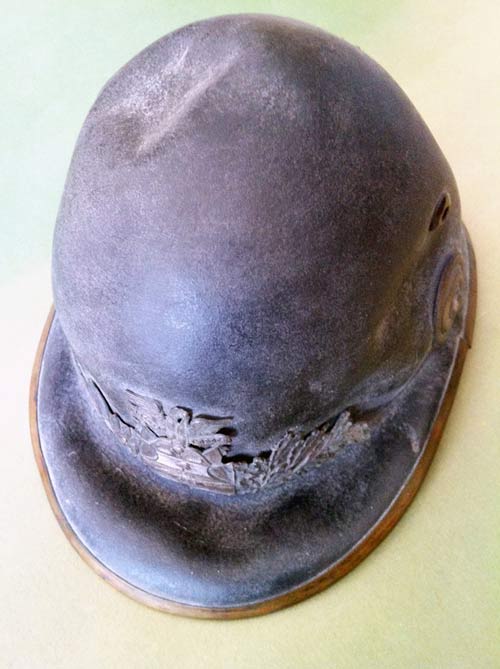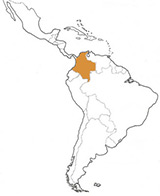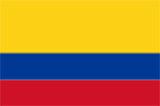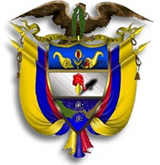Au début du XX° siècle, l’armée colombienne, en bien piètre état, n’a plus grand chose de commun avec l’impressionnante force révolutionnaire qui, moins d’un siècle auparavant (1819), avait arraché à l’Espagne l’indépendance de la moitié du continent. Jusqu’au début du XXIème siècle, les coiffures militaires colombiennes sont nombreuses mais rares sont les casques comme le modèle ci-dessous.
En 1907, les premières tentatives de restructuration professionnelle des forces nationales par le Président Rafael Reyes Prieto se heurtent d’ailleurs à la complète déliquescence de l’institution. Cependant, dès cette année, des casques à pointe M95 allemands font leur apparition.Une influence allemande
via le ChiliFace à cette situation décourageante, en l’absence de traditions nationales1, une assistance étrangère s’imposait manifestement. C’est le Chili qui fut choisi et, en 1909, une mission militaire venue de Santiago se mettait au travail. Les experts chiliens remirent l’armée sur pied à la prussienne dans un délai de deux ans.
Les tenues de parade de l’armée – et notamment bien sûr les Pickelhaube à la prussienne2 – ainsi que certaines traditions en portent toujours la marque3. Cette organisation, rationnelle et efficace, survécut jusqu’à la fin des années 1920.
En 1907, les premières tentatives de restructuration professionnelle des forces nationales par le Président Rafael Reyes Prieto se heurtent d’ailleurs à la complète déliquescence de l’institution. Cependant, dès cette année, des casques à pointe M95 allemands font leur apparition.Une influence allemande
via le ChiliFace à cette situation décourageante, en l’absence de traditions nationales1, une assistance étrangère s’imposait manifestement. C’est le Chili qui fut choisi et, en 1909, une mission militaire venue de Santiago se mettait au travail. Les experts chiliens remirent l’armée sur pied à la prussienne dans un délai de deux ans.
Les tenues de parade de l’armée – et notamment bien sûr les Pickelhaube à la prussienne2 – ainsi que certaines traditions en portent toujours la marque3. Cette organisation, rationnelle et efficace, survécut jusqu’à la fin des années 1920.

Casque de cuir, milieu du XIXème siècle. Les armes avec la devise Libertad y Orden correspondent à la période 1834-1861
(collection YP)
COLOMBIA
Colombia gained its independence from Spain in 1819, but as part of the larger country of Gran Colombia, which included today’s Ecuador and Venezuela. Gran Colombia was dissolved in 1830.
Constant warfare between conservatives and liberals characterized the political and military life of Colombia for most of the rest of the nineteenth century. Be-tween 1899 and 1902, a brutal civil war left 10,000 victims. Throughout this long period soldiers wore only hats or soft caps. However, there is evidence during the period 1834-1861 of a strange circular brown leather helmet sporting the national coat of arms on the front. More is not known about this headgear.
At the beginning of the twentieth century, an effort was made to establish a real army with the assistance of a Chilean military mission. The German manufactured Pickelhaube was introduced under the presidency of Rafael Reyes (circa 1909) . Police units wore their own type of spiked helmet.
In the 1930s a tropical Adrian-type lightweight helmet with a front emblem was introduced for officers.
Efforts to modernize the military at the end of the 1940s and early 1950s included the introduction of two German, light metal, Stahlhelm-type helmets. The first one being a copy of the German M16, the other clearly inspired by the M35. Both were painted dark green, and the second carried a frontal badge representing the national coat of arms.
Beginning in 1949 the US M1 began arriving to replace the fragile and aging German models. The lightweight version of the M1 was classically decorated with all sorts of side emblems. This included helmets worn by the Guardia Presidencial (GP).
Today the Army and Air Force use American helmets painted in their respective colors. Tank crews have always used a variety of headgear .
For parades, the GP still uses the M95 type Pickelhaube decorated with a frontal plate with the national coat of arms. Haarbushes of various colors are used on special occasions. However, one notes the recent return of the old German M16-type model at commemorative military parades.
Colombia gained its independence from Spain in 1819, but as part of the larger country of Gran Colombia, which included today’s Ecuador and Venezuela. Gran Colombia was dissolved in 1830.
Constant warfare between conservatives and liberals characterized the political and military life of Colombia for most of the rest of the nineteenth century. Be-tween 1899 and 1902, a brutal civil war left 10,000 victims. Throughout this long period soldiers wore only hats or soft caps. However, there is evidence during the period 1834-1861 of a strange circular brown leather helmet sporting the national coat of arms on the front. More is not known about this headgear.
At the beginning of the twentieth century, an effort was made to establish a real army with the assistance of a Chilean military mission. The German manufactured Pickelhaube was introduced under the presidency of Rafael Reyes (circa 1909) . Police units wore their own type of spiked helmet.
In the 1930s a tropical Adrian-type lightweight helmet with a front emblem was introduced for officers.
Efforts to modernize the military at the end of the 1940s and early 1950s included the introduction of two German, light metal, Stahlhelm-type helmets. The first one being a copy of the German M16, the other clearly inspired by the M35. Both were painted dark green, and the second carried a frontal badge representing the national coat of arms.
Beginning in 1949 the US M1 began arriving to replace the fragile and aging German models. The lightweight version of the M1 was classically decorated with all sorts of side emblems. This included helmets worn by the Guardia Presidencial (GP).
Today the Army and Air Force use American helmets painted in their respective colors. Tank crews have always used a variety of headgear .
For parades, the GP still uses the M95 type Pickelhaube decorated with a frontal plate with the national coat of arms. Haarbushes of various colors are used on special occasions. However, one notes the recent return of the old German M16-type model at commemorative military parades.



